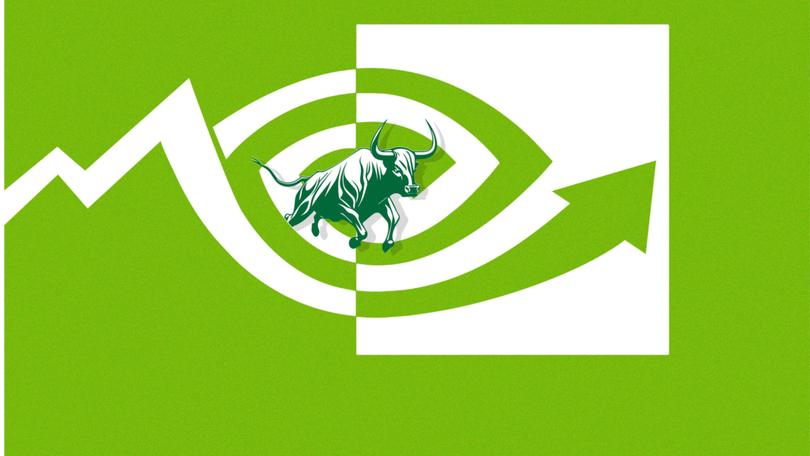The Economist: What could stop the Nvidia frenzy?

If today’s stock markets have their version of the great wildebeest migration, it is the stampede of the Nvidia bulls. Wall Street is no Serengeti, and Jim Cramer’s high-pitched narration no match for the dulcet tones of Sir David Attenborough. But in other respects investors’ headlong rush into the American chipmaker’s shares has been every bit as enthralling a spectacle.
Galloping sales of Nvidia’s artificial-intelligence (AI) processors have lifted its market capitalisation from $US350 billion ($525m) at the start of 2023 to $US1 trillion ($1.5trn), then $US2trn ($3trn), and then, this summer, $US3trn ($4.5trn). In June it overtook Microsoft, an AI-zealous software giant believed to be the biggest buyer of its chips, as the world’s most valuable firm.
It proceeded to lose that title—and $US900b ($1.35trn) in value — amid the recent stock market panic, only to claw back most of its losses in the past few weeks. As the firm prepares to report its latest results on August 28 just about everyone expects another blow-out quarter. “How much money have you made over the years betting against Jensen Huang?” Mr Cramer asked rhetorically on his CNBC show last week, referring to Nvidia’s boss. These days the Nvidia bear appears to be an endangered species. Or, as Sir David might whisper, “Not an Ursus nvidiaensis in sight.”
Sign up to The Nightly's newsletters.
Get the first look at the digital newspaper, curated daily stories and breaking headlines delivered to your inbox.
By continuing you agree to our Terms and Privacy Policy.For every hedge fund that trims its stake in the company, another seems to do the opposite. Of the 74 Wall Street analysts who cover Nvidia and are tracked by Bloomberg, 66 advise buying more of its shares; none suggests selling. Their average price target for the stock one year from now implies a market value of around $US3.5trn ($5.25trn).
James Anderson, a veteran tech investor who was an early backer, teases that Nvidia could be worth $US49trn in a decade, a shade more than the total value today of the S&P500 index of large American firms. All it would take is consistent annual sales growth of 60 per cent at current operating margins of 60 per cent or so, plus some plausible assumptions about cash flow. (Mr Anderson’s current employer, Lingotto, is owned by Exor, the biggest shareholder of The Economist’s parent company.)
Investment bankers at Jefferies, Goldman Sachs and UBS project that Nvidia’s yearly revenues will double this year, to over $US100b ($150b), grow by as much as half in 2025 and by double digits until at least 2027. By then its operating profit could exceed $US150bn — a third more than Apple, tech’s most successful money-spinner, managed last year. The numbers are getting so big, so fast, that this alone should give the bulls pause. As they catch their breath, they might wish to ruminate on two contradictions lurking in Nvidia’s long-term growth story.
The first concerns its main supplier. Nvidia designs chips but does not produce them. That falls to TSMC, a Taiwanese contract chipmaker that dominates the market for the cutting-edge silicon that goes into AI servers. As demand for these has rocketed, Nvidia has gone from one among many of TSMC’s clients to probably its second-biggest behind Apple. If it is indeed “customer B”, one of two that represent at least 10 per cent of TSMC’s revenues and must thus be disclosed in regulatory filings, it spent $US7.7b with TSMC last year, up from $US5.5b two years earlier. Given that most of Nvidia’s purchase commitments of $US19b for 2025 are likely to end up with TSMC, it could soon eclipse the current “customer A”, which handed the Taiwanese firm just shy of $US18b in 2023.
Even as Nvidia’s and TSMC’s fates become more entwined, however, their product cycles are diverging. Earlier this year Mr Huang vowed to launch a new and improved AI chip every year, rather than every couple of years. TSMC is therefore in a mad rush to expand capacity, pledging to invest up to $US32b ($48b) this year and possibly more in 2025. But it still needs at least 18 months to erect a new factory. And because these can cost $US20b a pop, careful discussions with clients typically start a year or two in advance. It is unclear how Nvidia’s accelerated timeline fits in with TSMC’s more measured pace of decision-making. In an early sign of trouble, Nvidia has delayed shipments of its latest chips, called Blackwell, by a couple of months owing to technical kinks.
Nvidia’s reliance on TSMC also highlights the second tension in the bulls’ case. Because the manufacturer controls the volume and efficiency of production, the only way for Nvidia to ensure that it meets investors’ bullish expectations for sales is to raise prices.
A Blackwell chip will cost 20-25 per cent more than the earlier generation, which was twice the price of the one before. Each chip is more powerful than the last, so the cost per unit of computing power is probably declining. But not fast enough for customers.
In August Andy Jassy, chief executive of Amazon, whose cloud-computing arm is a big user of Nvidia chips, acknowledged that he had “heard loud and clear from customers that they relish better price performance”. His company is investing in its own designs. So are Google, Meta, Microsoft and Tesla. AMD, a rival chip-designer, has gone from almost no AI-chip sales in 2022 to a forecast $US5b this year. On August 19th it said it would buy ZT Systems, a server maker, helping it to compete with Nvidia’s end-to-end offering. Chinese tech champions such as Huawei, barred by American sanctions from procuring top-end Nvidia gear, may forge breakthroughs that could do to Nvidia’s market share what Chinese competitors like BYD did to Tesla’s in electric cars.
Exit pursued by a bear
Assuming a killer app eventually emerges — which it hasn’t yet — generative AI is unlikely to become widely used unless it gets much cheaper; a ChatGPT query can cost seven times more to answer than Google search. Nvidia may soon have to choose between lowering prices to support its growth or maintaining prices to protect its profit margin. For now Nvidia bulls think they can have it both ways. The whiff of irrational exuberance may become too overwhelming for U. nvidiaensis to resist.
